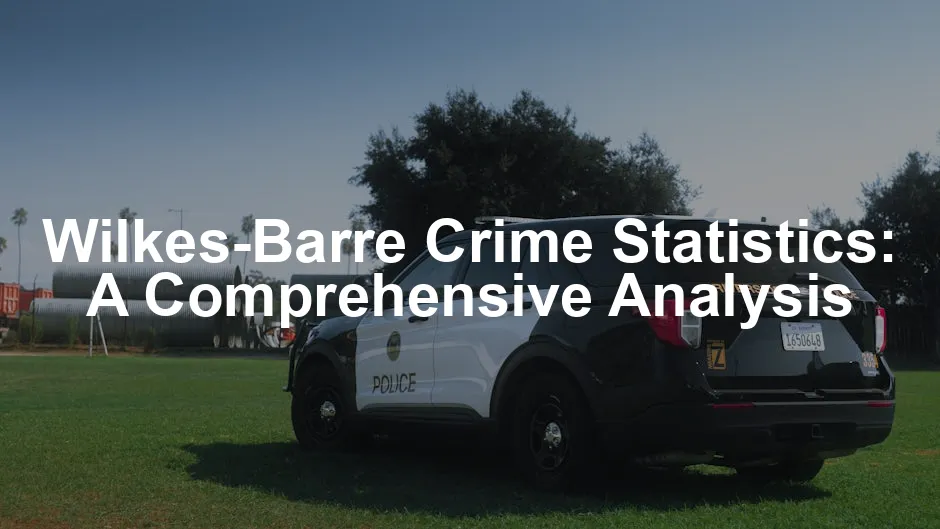Introduction
Nestled in the heart of Pennsylvania, Wilkes-Barre is a city with a rich history. Known for its scenic beauty and vibrant community, it sits at the intersection of the Susquehanna River and the Wyoming Valley. With a population of around 40,000, this city has a diverse demographic, blending families, students, and professionals. However, like many urban areas, Wilkes-Barre faces challenges, particularly concerning crime.
This article aims to provide an in-depth analysis of crime statistics in Wilkes-Barre. Understanding these numbers is crucial for residents, prospective movers, and local policymakers. Crime statistics offer insights into safety, helping communities implement necessary changes and improvements.
Throughout this article, we will dissect the crime rates, analyze trends, and offer comparisons with state and national averages. We will cover general crime rates, the crime index, and delve into violent and property crime statistics. By the end of this analysis, readers will have a clearer picture of the safety landscape in Wilkes-Barre.

Crime Overview
General Crime Rate
Wilkes-Barre has a crime rate of 20 crimes per 1,000 residents, significantly higher than the national average. This statistic indicates that residents face a 1 in 50 chance of becoming victims of crime. When we compare these figures with Pennsylvania’s state averages, Wilkes-Barre ranks higher than approximately 85% of other cities in the state.
Residents often express mixed feelings about safety. Surveys reveal that while 39% feel very safe, a notable 24% acknowledge feeling unsafe at times. This perception highlights the community’s need for ongoing safety discussions and improvements.
If you’re looking to enhance your home security, consider investing in a Home Security Camera System. With the ability to monitor your property remotely, you can keep an eye on your home, whether you’re there or away. This peace of mind is invaluable, especially in today’s world.

Crime Index
The crime index quantifies the safety of a city by evaluating the number of reported crimes. In Wilkes-Barre, this index indicates that the city is safer than only 12% of U.S. cities. The current crime index score reflects a troubling trend, suggesting a pressing need for community engagement and law enforcement strategies.
Recent years have shown fluctuations in the crime index, with scores ranging from a low of 4 to a high of 12. These numbers indicate that while there may be moments of improvement, the overall safety trajectory remains concerning. Residents and policymakers must be aware of these statistics to advocate for effective crime reduction strategies.
In summary, understanding crime statistics is vital for Wilkes-Barre’s residents and stakeholders. Awareness fosters community discussions about safety and informs decision-making for future initiatives. As we continue exploring detailed crime statistics, it becomes evident that knowledge is the first step towards a safer community.

Violent Crime Statistics
Overview of Violent Crimes
Violent crimes are serious offenses that include murder, rape, robbery, and assault. These acts not only threaten individual safety but also impact community wellbeing. In Wilkes-Barre, the violent crime rate stands at 4 per 1,000 residents. This figure is quite revealing, especially when compared to the national average of 2.8 per 1,000 residents. It indicates that residents of Wilkes-Barre face a higher likelihood of violent crime than many in other areas of the United States.
Understanding these statistics is paramount for residents and local leaders. A higher violent crime rate can lead to increased fear among residents and potential impacts on property values. It’s crucial to approach these numbers with both concern and the willingness to engage in community safety initiatives.
To enhance personal safety, consider carrying a Personal Safety Alarm. A compact device that can emit a loud sound to attract attention, it can be a great deterrent against potential threats. Peace of mind is just a button away!

Breakdown of Violent Crimes
Murder
In the last year, Wilkes-Barre reported 1 incident of murder. This statistic paints a relatively low picture compared to national averages, where cities often report much higher rates. The murder rate here is 0.02 per 1,000 residents, which is lower than Pennsylvania’s average of 2.2. While any murder is a tragedy, a single incident in a year reflects a community that, while facing challenges, is not overwhelmed by this particular crime.
Rape
Rape is a grievous crime that affects individuals deeply and has lasting repercussions. In Wilkes-Barre, there were 17 reported incidents of rape last year, translating to a rate of 0.38 per 1,000 residents. This number is just below the national average of 40.7 per 100,000 residents. Trends in reporting may vary, but community awareness and support systems play a key role in encouraging survivors to come forward.
Robbery
Robbery, often characterized by the use of force or threat, saw 27 incidents reported in Wilkes-Barre last year. This equates to a robbery rate of 0.61 per 1,000 residents. Comparatively, the national average for robbery is significantly higher, at 135.5 per 100,000 residents. While any robbery is concerning, the relatively low number in Wilkes-Barre suggests that residents may feel more secure in their neighborhoods when it comes to this type of crime.
Assault
Assault remains the most prevalent violent crime in Wilkes-Barre, with 132 incidents reported. This translates to a striking 2.98 per 1,000 residents. This rate is notably higher than the national average of 268.2 per 100,000 residents. The high number of assaults raises questions about community safety and the need for preventive measures.
When comparing Wilkes-Barre’s statistics with both Pennsylvania and national averages, it becomes evident that while some violent crime categories are lower, assault presents a challenge that calls for community action. The state average for assault is approximately 296.6 per 100,000 residents, making Wilkes-Barre’s rate particularly noteworthy.
For those looking to increase their personal defense, consider a Pepper Spray. Compact and easy to carry, it can be a lifesaver in emergency situations. Just a little spritz can give you the upper hand against an aggressor.

Conclusion
In summary, the violent crime statistics for Wilkes-Barre reveal a mixed picture. While murder and robbery rates are relatively low, the number of assaults indicates an area for community focus. Understanding these dynamics is essential for residents, local leaders, and law enforcement as they work to create a safer environment. By recognizing the nuances within these statistics, the community can take informed steps toward improvement and safety enhancement.

Breakdown of Property Crimes
Property crimes encompass a range of offenses, including burglary, theft, and motor vehicle theft. In Wilkes-Barre, these crimes have shown both stability and fluctuation over recent years, reflecting broader trends in urban safety.
Burglary
Wilkes-Barre experienced 85 incidents of burglary last year. This statistic corresponds to a burglary rate of 1.92 per 1,000 residents. While this number might sound alarming, it’s essential to recognize that it represents a relatively stable trend. Over the past few years, burglary incidents have not drastically increased, showing that community efforts to bolster neighborhood watch programs and increase police presence may be having a positive impact.
Theft
Theft is the most common property crime in the city, with 580 reported incidents last year. This figure translates to a remarkable 13.10 thefts per 1,000 residents. Within this category, larceny and shoplifting are significant contributors. Larceny, which includes the unlawful taking of someone else’s property, accounts for a substantial portion of these figures. Shoplifting, while difficult to quantify separately, also plays a significant role in bolstering these numbers. This high incidence underlines the necessity for retail businesses to implement stronger security measures, including surveillance systems and staff training.

Motor Vehicle Theft
Motor vehicle theft is another area of concern, with 52 incidents recorded, resulting in a rate of 1.17 per 1,000 residents. While this number may seem modest compared to theft, it still poses a concern for vehicle owners. The low rate in Wilkes-Barre could suggest effective law enforcement strategies, but it also emphasizes the need for residents to remain vigilant about their vehicle security.
When we compare these property crime statistics to state and national averages, a clearer picture emerges. Pennsylvania’s average property crime rate stands at 14.83 per 1,000 residents, while the national average is 20 per 1,000 residents. Wilkes-Barre’s rate of 16 per 1,000 residents indicates a community that is navigating property crime challenges effectively but still requires ongoing attention and community engagement.

To further protect your home, consider displaying a Neighborhood Watch Sign. It can serve as a deterrent for potential criminals and shows that the community is vigilant and proactive about safety.
Overall, while the property crime landscape in Wilkes-Barre presents certain challenges, current statistics suggest that both residents and law enforcement are making strides toward a safer environment. Enhanced community awareness and proactive measures can only bolster these efforts, leading to a more secure Wilkes-Barre for everyone.

Neighborhood Safety Analysis
Safe Neighborhoods
Wilkes-Barre boasts several neighborhoods that stand out for their safety, providing residents with peace of mind. Among the safest areas are City Center/Kings College and Miners Mills.
City Center/Kings College is not just a hub for students but also a vibrant community where safety thrives. The presence of law enforcement and community events fosters a sense of security. Residents often report feeling quite safe, with local initiatives promoting neighborhood engagement.
Miners Mills is another gem within Wilkes-Barre. This neighborhood is known for its close-knit community feel. Residents here often look out for one another, which contributes to a lower crime rate. Notable trends show that community efforts, such as neighborhood watch programs, are pivotal in maintaining safety.

These neighborhoods highlight that when residents come together, they can create safer spaces. The sense of community in these areas is not just about low crime rates; it’s about fostering relationships and building trust among neighbors.
High-Crime Areas
While there are safe havens, some neighborhoods in Wilkes-Barre experience higher crime rates. Areas such as South Wilkes-Barre and East End have been identified as having elevated crime levels.
Potential reasons for the higher crime rates include socioeconomic factors such as poverty and unemployment. According to recent statistics, Wilkes-Barre has a poverty rate of 23.3%, significantly higher than the national average of 15.1%. Economic instability often correlates with increased crime as individuals may resort to illegal activities for financial gain.
Moreover, housing density and community disengagement can lead to increased crime rates. In neighborhoods where residents may not be as connected or involved in community activities, crime can become more prevalent.

If you’re looking to stay safe while exploring these neighborhoods, consider a Self-Defense Keychain. It’s a discreet and practical tool to help you feel more secure when out and about.
In summary, understanding the landscape of both safe and high-crime neighborhoods is crucial for residents and local policymakers. Awareness of these dynamics can prompt community-led initiatives aimed at fostering safety and reducing crime.

Year-Over-Year Trends
Historical Crime Data
Over the past five years, Wilkes-Barre has experienced a notable shift in crime trends, with statistics revealing both increases and decreases across various crime categories. The overall crime rate currently stands at 20 crimes per 1,000 residents, which is significantly above the national average. However, a closer look reveals a mixed bag of results.
In 2022, the city reported 177 violent crimes, translating to a violent crime rate of 4 per 1,000 residents. This figure is higher than the Pennsylvania average of 2.8 per 1,000 residents. Interestingly, the violent crime rate has seen a 26.9% decline from the previous year, indicating positive momentum in community safety and law enforcement efforts.
On the property crime front, Wilkes-Barre recorded 717 incidents, resulting in a property crime rate of 16 per 1,000 residents. This statistic also reflects a 15.9% decrease compared to the previous year, suggesting that initiatives aimed at crime prevention are beginning to yield results.
Graphs and charts can vividly illustrate these trends, showcasing the fluctuations in crime rates year over year. For instance, a bar chart could represent the decline in violent and property crimes, while a line graph could display the overall crime rate trajectory. Such visual aids would further enhance the understanding of crime dynamics in Wilkes-Barre.

Future Projections
Looking ahead, several factors might influence the future crime rates in Wilkes-Barre. Economic conditions play a vital role. With the city’s poverty rate hovering around 23.3%, which is significantly higher than the national average, economic instability could lead to increased crime rates.
Additionally, changes in law enforcement strategies and community engagement efforts can impact crime trends. Experts suggest that ongoing investment in community policing, crime prevention programs, and neighborhood watch initiatives could pave the way for further reductions in crime.
Local law enforcement officials are optimistic about future projections, emphasizing the importance of partnerships with community organizations. By fostering trust and collaboration, they can address root causes of crime more effectively.
In summary, while Wilkes-Barre’s crime statistics present challenges, there are signs of improvement. Continued focus on economic development and community involvement is essential for sustaining this positive trend. With concerted efforts, the city can work towards a safer environment for all residents.

Community Initiatives
Wilkes-Barre is not just about statistics; it’s about community! Local programs are actively promoting crime prevention and public safety. One noteworthy initiative is the Neighborhood Watch Program. This grassroots effort empowers residents to keep an eye on their surroundings. Together, they create a safer environment by reporting suspicious activities to law enforcement.
Another gem is the Wilkes-Barre Community Police Initiative. Officers partner with residents to build trust and foster open communication. This collaboration helps bridge gaps and encourages community members to voice their concerns.
So, how can you get involved? Start by attending local meetings or events hosted by these programs. Volunteer your time or simply spread the word. Every little bit helps! Engaging in these initiatives not only enhances safety but also builds a stronger community bond. Let’s rally together and make Wilkes-Barre a safer place for all.

FAQs
What are the chances of becoming a victim of crime in Wilkes-Barre?
In Wilkes-Barre, the chance of becoming a victim of crime is about 1 in 50. This statistic highlights the importance of remaining vigilant and informed about local crime trends. While some may feel secure, others may experience apprehension. Understanding these chances helps residents take proactive steps towards their safety.
How does Wilkes-Barre compare to other cities in Pennsylvania?
When compared to nearby towns, Wilkes-Barre’s crime rate stands out. It is higher than approximately 85% of Pennsylvania cities, indicating a pressing need for community action. Cities like Scranton and Kingston have lower crime rates, making Wilkes-Barre’s statistics even more concerning. Awareness of these comparisons can help residents understand their safety context.
What should residents do to stay safe?
Residents should stay informed about their surroundings and participate in local community safety programs. Simple steps such as locking doors, being aware of unusual activity, and getting involved in neighborhood watch initiatives can make a difference. Additionally, utilizing local resources like police departments or community centers can provide valuable safety information.
Where can I find more information about Wilkes-Barre crime statistics?
For those seeking further insights, websites like NeighborhoodScout and AreaVibes offer detailed crime data and statistics. Local law enforcement agencies also provide resources and reports that help residents stay informed. Engaging with these platforms will enhance your understanding of crime trends in Wilkes-Barre.
Please let us know what you think about our content by leaving a comment down below!
Thank you for reading till here 🙂
For a comprehensive analysis of safety in 2023, you can explore the Fremont crime statistics.
To be prepared for emergencies, consider having a First Aid Kit handy at home. You never know when you might need it, and being prepared can make all the difference in an emergency.
Consider investing in an Emergency Blanket for your safety kit. It’s lightweight, compact, and can help maintain body heat in dire situations.
Lastly, a Flashlight with Rechargeable Batteries is essential for any emergency kit. It ensures you’re never left in the dark, quite literally!
All images from Pexels




